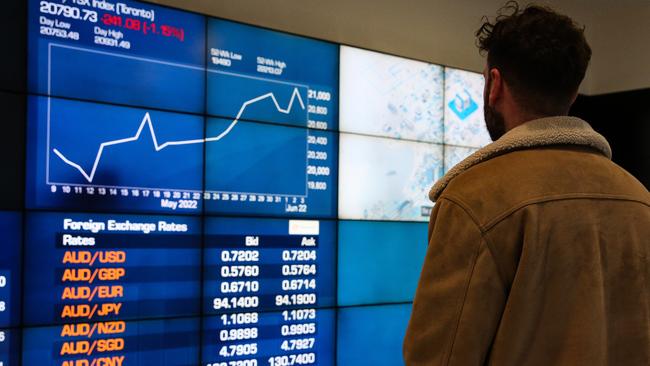Earnings outlook weakens as challenges mount
The local bourse added 1.1 per cent for the week, notching up its fifth straight week of gains, but there is a creeping sense of anxiety about the outlook for corporate earnings and dividends.

Continued support for the Australian sharemarket so far this reporting season belies a creeping sense of anxiety about the outlook for corporate earnings and dividends in a deteriorating macroeconomic environment due to rising costs and slowing economic growth.
The local bourse added a solid 1.1 per cent for the week to be up five weeks in a row.
An 11 per cent bounce in the benchmark S&P/ASX 200 index from a 19-month low in June has tracked an 18 per cent rebound in the US market as a slight easing of inflationary pressures fuelled hope that the Federal Reserve would soon be able to slow the pace of hikes and start to cut next year.
UBS equity strategist Richard Schellbach say the median company has actually beaten the consensus estimate for earnings by 0.3 per cent and “beats” have outnumbered “misses” by 3 to 1, an “impressive showing” given the headwinds companies have faced over the last six months”.
But a less rosy picture may emerge next week as more domestic and consumer-related companies report.
Moreover there has been a continued downward revision of earnings estimates for fiscal 2023.
“Over the last week, the negative momentum in earnings revisions has picked up in pace with 2023 estimates being most harshly dealt with, as concerns over a slowing economy continue to fester,” Schellbach says. “This may intensify next week as domestically focused businesses report.”
A silver lining is that share prices have for the most part been able to “digest” downgrades of earnings forecasts by analysts thanks to already discounted valuations.
“A key facilitator behind the recent decoupling of rising share prices and falling earnings has been lowered expectations,” Schellbach says.
“Leading into results, the ASX 200 was trading at a forward price-to-earnings ratio below 14 times, which is just below its long-run average of 14.5 times, but more importantly far below the 17-20 times range seen leading into recent reporting periods.”
But while the June half-year reporting season has started out okay it may weaken as it did in 2021. At that time investors became concerned about the outlook due to Covid lockdowns. A lack of guidance from many companies offset solid earnings and dividends and share buybacks, and the ASX 200 topped out midway through reporting season.
“More than normal this reporting season we’ve seen strong share price reactions to the upside where companies are in line or better with their earnings guidance commentary, and to the downside where guidance is lower than expected, or absent,” said Barrenjoey head of research Craig Stafford.

“The macro environment continues to dominate, with no company immune from rising costs and increasing uncertainty in the economic outlook – besides a select few, such as Medibank, which continues to benefit from a benign health insurance claim environment and a lack of hospital contract renewals.”
AMP Capital’s head of investment strategy and chief economist Shane Oliver says that in aggregate terms reporting season has been “a bit soft” in terms of the percentage of companies exceeding market expectations. He says 33 per cent of earnings reports have surprised on the upside relative to expectations. However that was well below the decade average of about 43 per cent.
Oliver notes 58 per cent of companies have reported a rise in earnings compared to a year ago and 52 per cent have increased dividends.
But those percentages are also average, “reflecting the cost pressures some businesses are facing”.
“Overall results are a bit soft, and they have slowed down since the initial recovery from the pandemic lockdowns,” Oliver says.
He also notes that a significant proportion of reporting companies have flagged earnings growth this year below inflation. That may be a problem for investors if inflation doesn’t fall rapidly.
Potentially reflecting such observations, Oliver says only 45 per cent of reporting companies have seen their share prices outperform the market on the day results were released, well below a norm of 54 per cent.
Oliver says markets globally remain at “high risk of a pullback” in the months ahead as central banks continue to tighten to combat high inflation, uncertainty about recession remains high and geopolitical risks continue. But he expects reasonable returns on a 12-month horizon as valuations have improved, global growth should ultimately rebound and inflationary pressures ease through next year allowing central banks to slow up on the monetary policy brakes.
Next week investors face the busiest part of the reporting season as results from over 100 companies covering around 25 per cent of total market capitalisation are due to report. “The focus will likely be on outlook statements given cost pressures, labour shortages and slowing consumer demand,” says Oliver.




To join the conversation, please log in. Don't have an account? Register
Join the conversation, you are commenting as Logout